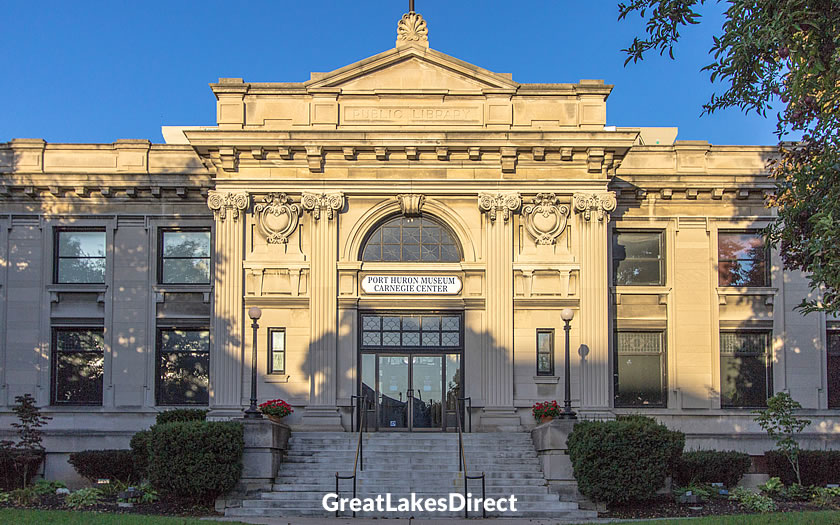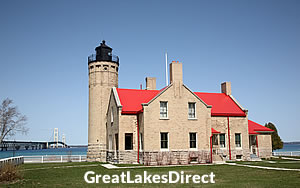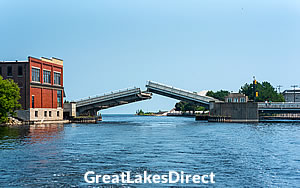Port Huron is known as the maritime capital of the Great Lakes with a rich nautical history. As the easternmost point in Michigan's Lower Peninsula, it's often referred to as the gateway to Canada, visible across the impressive Blue Water Bridge.
The city is located where the waters of Lake Huron meet the St. Clair River. The northern and southern parts of Port Huron are also divided by the Black River.

Blue Water Bridge connecting Port Huron with Ontario
With its location on the Canadian border and proximity to the metropolis of Detroit, the city has long been an important trade and transportation hub. But Port Huron also offers visitors stunning views and a variety of recreational activities, from boating and fishing to exploring the scenic Blue Water River Walk.
The most convenient airport for Port Huron is Detroit Metropolitan Wayne County Airport. Certainly visitors arriving from international destinations or flying long distance within the USA should put this option at the top of their list.
Smaller alternatives are available at Flint, Lansing and Grand Rapids.
Distance to Bishop International Airport (Flint): 72 miles
Distance to Detroit Metro Airport: 78 miles
Distance to Capital Region International Airport (Lansing): 123 miles
Distance to Gerald R. Ford International Airport (Grand Rapids): 173 miles
Rail services to Port Huron operate on an Amtrak high-speed connection from Chicago, stopping at East Lansing and Flint (among other destinations along the way). The service is known as the Blue Water line.
There are no rail connections to Canada, although a service runs from Sarnia (on the other side of the St Clair River) through to Toronto.
There is a daily bus service to and from Port Huron from Detroit, with connections from there through to other US destinations.
The I-69 interstate highway heads west from Port Huron towards Lansing and then turns south towards the Indiana state line.
The I-96 interstate highway runs south-west from Port Huron towards Detroit. In Detroit it turns west towards Lake Michigan and eventually terminates in Montana.
The M-25 state highway leads north along the shore of Lake Huron towards Port Sanilac and Port Austin and then south-west towards Bay City.
If you know when you are planning to go but haven't decided on accommodation, then use the map below to get an idea of which properties are available and to compare prices during the period you wish to travel.
Enter your proposed dates and use the '+' to zoom in on a location and reveal more properties. Click on the price above a property to see more information.
(Please note that this selection will also include some vacation rentals for those who are interested in that form of accommodation!)
Alternatively, if you are looking for a list of properties available in Port Huron you can check the accommodation listings on reservation platform Booking.com:
The Port Huron area was settled by the Chippewa people at the time of the first French and British fur traders who arrived in the region.
Its strategic location at the confluence of Lake Huron and the St. Clair River was vital as it served as the waterway between Lake Erie and Lake Huron, which was crucial for trade and transportation.
Throughout the 19th century, Port Huron experienced significant growth, due in part to the lumber boom that followed the opening of the Erie Canal in 1825. This boom was further fueled when Michigan gained statehood in 1835, and the city's advantageous location continued to encourage its development.
The village of Port Huron was officially founded in 1849. It was incorporated as a city in 1857, just two decades after Michigan became a state.
Port Huron was also involved in Michigan's first commercial oil production, which began in 1886 with twenty-two wells drilled. The city was the site of Michigan's first electric railroad that same year, the third of its kind in the nation and a sign of Port Huron's early adoption of technological advances.
Those approaching Port Huron on the I-96 will see the Port Huron Welcome Center which offers visitors information and brochures. It is open all week in the summer months and on weekdays in the winter.
The Fort Gratiot Lighthouse is the oldest lighthouse in Michigan. The original Fort Gratiot was built during the War of 1812 to protect the vital strategic waterway where Lake Huron meets the St. Clair River.
The first lighthouse was built in 1825, but poor construction caused it to collapse a few years later. The current lighthouse was opened in 1829 and, after renovations in the 19th century, now stands 82 feet tall on the headland.

Fort Gratiot Lighthouse in Port Huron
The lighthouse is open every day for tours in the summer months and visitors can admire the views over the river, the lake and the Blue Water Bridge.
The main Port Huron Museums organisation actually looks after the Carnegie Center, the Huron Lightship and the Thomas Edison Depot Museum.
Most of the exhibits in what would be termed the Port Huron Museum are located in the Carnegie Center, which is the former public library. They include a large collection of ship models, historical documents and photographs, and recreations of what life looked like in rural Michigan.

Port Huron Museum in the Carnegie Center
The Huron Lightship is moored on the St Clair River. The lightship formerly operated on Lake Huron six miles north of Port Huron and was the last working lightship until it was decommissioned in 1970. It is listed as a National Historic Landmark.
The Thomas Edison Depot Museum is located in the former Fort Gratiot train depot. Inventor Thomas Edison worked out of the depot between 1859 and 1864. Most of the exhibits explain the trials that a young Thomas Edison faced and his development into the famous inventor.
Some of the exhibits are housed in a restored baggage car outside the main museum building.

Mackinaw City is a popular tourist destination located at the northern tip of Michigan's Lower Peninsula and is a gateway to the Upper Peninsula as well as nearby Mackinac Island. Visitors can also explore the nearby Colonial Michilimackinac State Park, which offesrs historic sites and reenactments.

Alpena is a city located on the Thunder Bay River, which flows into Lake Huron. It is the main gateway for the Thunder Bay National Marine Sanctuary, which is home to more than 100 shipwrecks protected by the cold waters of the lake. The Great Lakes Maritime Heritage Center in Alpena is the visitor center for the sanctuary.

Port Austin is located on the tip of the 'Thumb' of Michigan's 'Mitten'. It is known for its beautiful sand beaches, which are perfect for swimming, boating, and relaxing in the sun. Visitors can also explore the nearby Port Crescent State Park, which offers hiking trails and a beach. The much-photographed Turnip Rock is just a few miles to the east.

Once a lumber settlement, Port Sanilac is said to have been named in honor of a Wyandotte chief, Sanilac. The town is home to the Port Sanilac Lighthouse, which has been in operation since 1886, and an 1850 Victorian mansion that now serves as a museum. A number of shipwrecks lie off the coast of Port Sanilac.
Port Huron: porthuron.org
Port Huron Museum: www.phmuseum.org